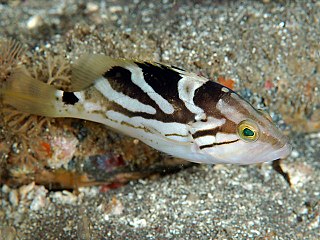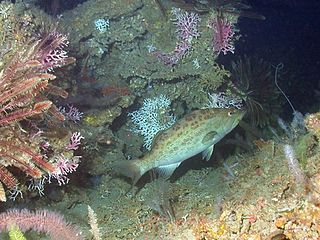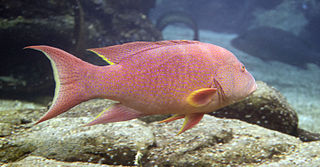
The comet grouper, also known as the comet cod or dot-dash grouper, is a species of marine ray-finned fish, a grouper from the subfamily Epinephelinae which is part of the family Serranidae, which also includes the anthias and sea basses. It is a species of deep coral reefs in the Indo-Pacific region.

The yellow-edged lyretail also known as the yellowedge coronation trout, fairy cod, lunar tail rock cod, lunartailed cod, lyre-tail cod or moontail seabass,, is a species of marine ray-finned fish, a grouper from the subfamily Epinephelinae which is part of the family Serranidae, which also includes the anthias and sea basses. It is found in the Indo-Pacific region and is more common than the congeneric white-edged lyretail.
The tenspine grouper is a species of marine ray-finned fish, a grouper from the subfamily Epinephelinae which is part of the family Serranidae, which also includes the anthias and sea basses. It is found along the western coast of Mexico and Central America, but is a very rare fish of which little information exists.

The Marquesan grouper is a species of marine ray-finned fish, a grouper from the subfamily Epinephelinae which is part of the family Serranidae, which also includes the anthias and sea basses. It is endemic to French Polynesia. Its natural habitats are open seas, shallow seas, subtidal aquatic beds, and coral reefs.

The snowy grouper is a species of marine ray-finned fish, a grouper from the subfamily Epinephelinae which is part of the family Serranidae, which also includes the anthias and sea basses. It is found in the western Atlantic Ocean.
The Venezuelan grouper is a species of marine ray-finned fish, a grouper from the subfamily Epinephelinae which is part of the family Serranidae, which also includes the anthias and sea basses. It is found in northern South America and the Greater Antilles.

Variola, the lyretails, is a genus of marine ray-finned fish, groupers from the subfamily Epinephelinae, part of the family Serranidae, which also includes the anthias and sea basses. They are found in the tropical Indo-Pacific and their distribution extends from the Red Sea to South Africa across the Indian Ocean and east to the islands of the central Pacific.

Cephalopholis fulva, the coney or the butterfish, is a species of marine ray-finned fish, a grouper from the subfamily Epinephelinae which is in the family Serranidae which also includes the anthias and sea basses. It is found in the western Atlantic. It is associated with reefs and is a quarry species for commercial and recreational fisheries. It can be found in the aquarium trade.

The golden grouper, also known as the pink grouper or Powell's grouper, is a species of marine ray-finned fish, a grouper from the subfamily Epinephelinae which is part of the family Serranidae, which also includes the anthias and sea basses. It is found in the eastern Indian Ocean and Western Pacific Ocean.

Bellator militaris, the horned sea robin, is a species of marine ray-finned fish belonging to the family Triglidae, the sea robins. This fish is found in the western Atlantic Ocean.

Liopropoma rubre, the peppermint bass or swissguard basslet, is a species of marine ray-finned fish, related to the groupers and classified within the subfamily Epinephelinae of the family Serranidae. It is found in the western Atlantic Ocean. This species is utilised in the aquarium trade.

The scamp grouper, also known as scamp, is a species of marine ray-finned fish, a grouper from the subfamily Epinephelinae which is part of the family Serranidae, which also includes the anthias and sea basses. It is found in the western Atlantic Ocean.
The yellowmouth grouper, also known as the crossband rockfish, grey mannock, hamlet, harlequin rockfish, princess rockfish, rockfish, salmon grouper, salmon rock fish or scamp, is a species of marine ray-finned fish, a grouper from the subfamily Epinephelinae which is part of the family Serranidae, which also includes the anthias and sea basses. It is found in the Caribbean and in the tropical waters of the Atlantic Ocean. It is also found in pockets in Brazil. It is a fairly large fish and it gets its name from the yellow around its mouth.
Liopropoma carmabi, the candy basslet, is a species of fish in the family Serranidae.

Liopropoma santi, the spot-tail golden bass, is a species of marine ray-finned fish, related to the groupers and classified within the subfamily Epinephelinae of the family Serranidae. It has been collected from deep reefs off Curaçao, southern Caribbean; it is the deepest occurring Liopropoma species in the Atlantic Ocean.

The whitespotted grouper, also known as the rankin cod, ocellated rockcod, small-spotted cod, white-spotted reef-cod or whitespotted rockcod, is a species of marine ray-finned fish, a grouper from the subfamily Epinephelinae which is part of the family Serranidae, which also includes the anthias and sea basses. It has an Indo-Pacific distribution. It is closely related to two other species of white spotted groupers in the genus Epinephelus.

The masked grouper, also known as the thinspine grouper, rededged cod, red-edged grouper, slenderspine grouper, thinspine rockcod, white-margined grouper, white-square cod or white-square grouper, is a species of marine ray-finned fish, a grouper from the subfamily Epinephelinae which is part of the family Serranidae, which also includes the anthias and sea basses. It is found in the western Atlantic Ocean. It is the only species in the genus Gracila.

The white-edged lyretail, also known as the white-edge coronation trout, lyretail grouper, lyretail trout, white-edged lyretail-cod or white-fringed moontail-bass, is a species of marine ray-finned fish, a grouper from the subfamily Epinephelinae which is part of the family Serranidae, which also includes the anthias and sea basses. It is found in the Indo-Pacific region but it is an uncommon species.

Hyporthodus mystacinus, the misty grouper, black grouper, convict grouper, eightbar grouper or moustache grouper, is a species of marine ray-finned fish, a grouper from the subfamily Epinephelinae which is part of the family Serranidae, which also includes the anthias and sea basses. It is primarily found in the Caribbean and the Gulf of Mexico with populations present around the Galapagos Islands and Central American coastlines.

The Spanish flag is a species of marine ray-finned fish, a grouper from the subfamily Epinephelinae which is part of the family Serranidae, which also includes the anthias and sea basses. It is found in the western Atlantic Ocean. It is the only species in the genus Gonioplectrus.
















